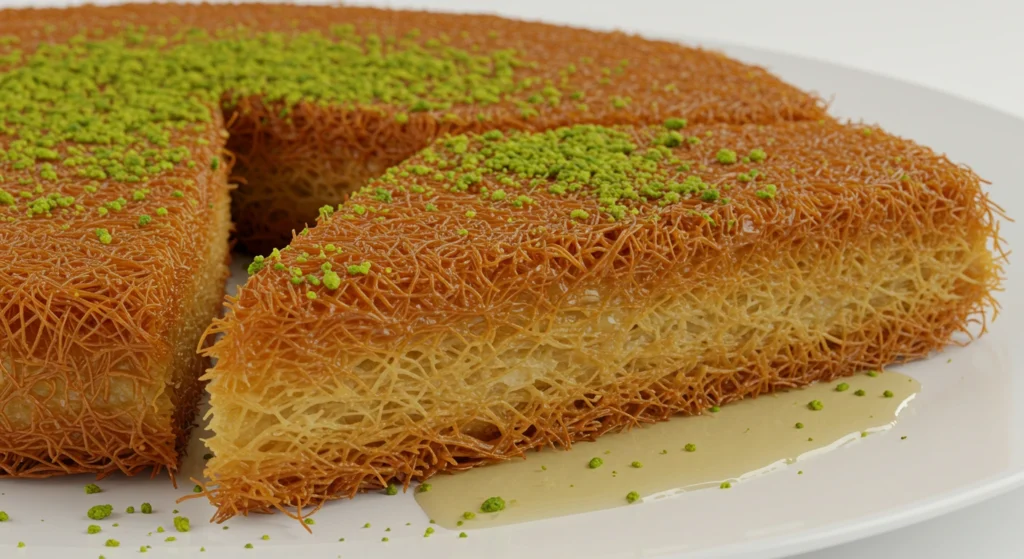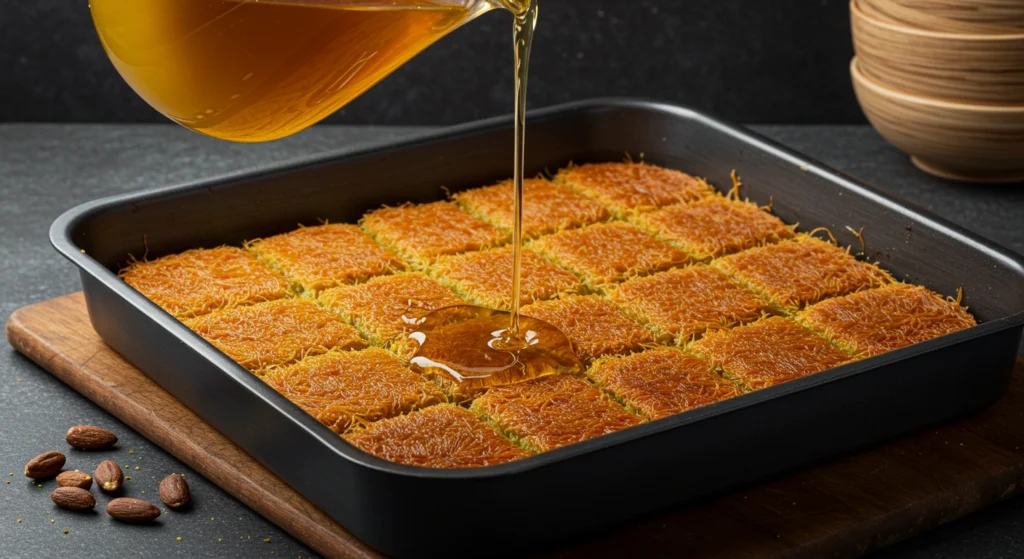intoduction : Knafeh
Knafeh is a truly delightful Middle Eastern dessert. This cheese pastry soaked in sweet, sugar-based syrup is loved across many cultures.
The Amazing Origins of Knafeh:Knafeh
Knafeh boasts a rich history with its roots stretching back centuries. While its exact origin is debated, many believe it originated in the Palestinian city of Nablus. Some accounts suggest it was created to satisfy a caliph’s hunger during Ramadan. The precise history is debated, but knafeh’s cultural significance remains strong.
Knafeh’s Spread Through the Middle East
From Palestine, knafeh spread throughout the Middle East. Variations emerged across different regions. Each culture added its unique touch, transforming the dessert into something distinct. For example, some versions use different cheeses or toppings.
Knafeh’s Enduring Popularity
Despite its historical roots, knafeh remains incredibly popular. Its unique texture and flavor profile have cemented its place as a beloved dessert. It is enjoyed during celebrations, holidays, and everyday occasions.
Knafeh Fundamentals
Knafeh is more than just a dessert; it’s an experience. The combination of textures and flavors creates something truly special. Understanding the core components is essential to appreciating its culinary appeal.
The Kataifi Dough
The base of many knafeh variations is kataifi dough. Kataifi consists of thin strands of shredded phyllo dough. This gives knafeh its signature crispy texture when baked.
The Cheese Component
Cheese plays a crucial role in knafeh. Nabulsi cheese is traditionally used. However, other cheeses like Akkawi or mozzarella are common substitutes. The cheese provides a creamy, slightly salty counterpoint to the sweet syrup.
Image Placeholder: alt text “knafeh ingredients” – shows kataifi dough, cheese, and ghee, along with the syrup ingredients.
The Sweet Syrup (Ater)
The sweet syrup, often called ater, is crucial. It’s made from sugar, water, and lemon juice or rose water for flavoring. The syrup is poured over the hot knafeh, soaking it through.
Toppings and Garnishes
Knafeh can be topped with various garnishes. Chopped pistachios are a common choice, adding color and a nutty flavor. Sometimes, a sprinkle of rose petals adds an aromatic touch.
The 3 Main Types of Knafeh
Different regions and preferences have led to variations of knafeh. Each type offers a unique culinary experience. Let’s explore three of the most popular versions.
Knafeh Nabulsi
Knafeh Nabulsi originates from Nablus, Palestine. It uses Nabulsi cheese, a white brine cheese. This cheese melts beautifully when heated, giving the knafeh a stringy, cheesy texture. It’s often dyed orange with food coloring.
Knafeh Bel Jiben
Knafeh Bel Jiben refers to knafeh with cheese. This version emphasizes the cheese filling. It often uses Akkawi cheese or a mix of cheeses.
Knafeh Nabulsieh
Knafeh Nabulsieh is a popular variant. It is characterized by its vibrant orange color and the use of semolina dough for its crust. The cheese is similar to Knafeh Nabulsi.

How to Make Knafeh: A Step-by-Step Guide
Making knafeh at home can be a rewarding experience. Although it might seem intimidating, following a step-by-step guide makes it manageable. Here’s a simplified recipe to get you started.
Preparing the Ingredients
Gather your ingredients first. You will need kataifi dough, Nabulsi or mozzarella cheese, butter or ghee, sugar, water, lemon juice, and pistachios. Preparing the ingredients ensures a smooth cooking process.
Assembling the Knafeh
Melt the butter or ghee and toss it with the shredded kataifi dough. Press half of the kataifi mixture into a baking dish. Layer the cheese evenly over the kataifi. Top with the remaining kataifi.
Baking the Knafeh
Bake in a preheated oven at 350°F (175°C) for 30-40 minutes. The knafeh should be golden brown and crispy.
Image Placeholder: alt text “finished knafeh on a plate” – a beautifully plated portion of golden brown knafeh.
Preparing and Adding the Syrup
While the knafeh is baking, prepare the syrup. Combine sugar, water, and lemon juice in a saucepan. Bring to a boil and simmer until slightly thickened. Once the knafeh is out of the oven, immediately pour the hot syrup over it.
Garnishing and Serving
Garnish with chopped pistachios. Serve warm for the best experience. The combination of warm pastry and sweet syrup is irresistible.
Tips for the Ultimate Knafeh
Achieving the perfect knafeh requires attention to detail. Here are some tips to help you elevate your knafeh game.
Choosing the Right Cheese
Selecting the right cheese is crucial. Nabulsi cheese is traditional, but mozzarella can work well too. Ensure the cheese melts properly and has the right flavor.
Achieving the Perfect Crisp
To achieve a perfectly crispy crust, evenly distribute the kataifi dough. Press it firmly into the baking dish. Baking at the right temperature is also essential.
The Importance of Hot Syrup
Pouring hot syrup over hot knafeh ensures proper absorption. This is key to getting the desired sweetness and moisture. Do not let either cool down before combining.
Customizing Your Knafeh
Don’t be afraid to experiment with flavors. Try adding rose water or orange blossom water to the syrup. You can also experiment with different toppings and nuts.
Health Considerations and Knafeh
While knafeh is delicious, it’s essential to consider its nutritional profile. Like many desserts, it is high in sugar and calories. Moderation is key.
Nutritional Value
Knafeh is rich in carbohydrates and fats. It also contains some protein from the cheese. However, it is not a significant source of vitamins or minerals.
Portion Control
Due to its high sugar and calorie content, portion control is important. Enjoy knafeh in moderation as part of a balanced diet.
Healthier Alternatives
If you’re health-conscious, consider making healthier alternatives. You can reduce the sugar in the syrup. You can also use lower-fat cheeses.
Knafeh Around the World
Knafeh has traveled far and wide. Different cultures have embraced and adapted it. This has resulted in many fascinating variations.
Regional Variations
In Turkey, it’s known as Künefe. In Greece, it’s called Kanafeh. Each region has its own unique twist on the recipe.
Knafeh in Modern Cuisine
Modern chefs have embraced knafeh. They have incorporated it into innovative dishes. From knafeh-filled croissants to knafeh ice cream, the possibilities are endless.
The Future of Knafeh
Knafeh will continue to evolve and inspire. Its enduring appeal ensures its place in culinary traditions.
Serving Suggestions and Pairings
Knafeh is delicious on its own, but it can be elevated with thoughtful serving suggestions and pairings. Understanding these nuances can enhance the overall experience.
Traditional Serving Methods
Traditionally, knafeh is served warm, often immediately after being soaked in syrup. It’s typically served in individual portions or as a larger dish to be shared. The warmth enhances the texture and flavors.
Complementary Beverages
Pairing knafeh with the right beverage can create a balanced and delightful experience. Middle Eastern coffee, particularly Turkish coffee or Arabic coffee, is a classic choice. The strong, slightly bitter coffee cuts through the sweetness of the knafeh. Tea, especially mint tea, is another popular option.
Creative Pairings
For a more modern twist, consider pairing knafeh with ice cream. Vanilla or pistachio ice cream complement the warm pastry and sweet syrup. Fruit, such as fresh berries or figs, can also provide a refreshing contrast.
Cultural Significance and Traditions
Knafeh is more than just a dessert; it’s an integral part of Middle Eastern culture and traditions. Understanding its cultural context enriches the appreciation for this dish.
Knafeh in Celebrations
Knafeh is often served during special occasions such as Ramadan, Eid, weddings, and family gatherings. It symbolizes hospitality, generosity, and celebration. Its presence at these events highlights its importance in cultural traditions.
Knafeh and Community
The preparation and sharing of knafeh often involve community participation. Families and friends come together to make and enjoy this dessert. It fosters a sense of togetherness and strengthens social bonds.
Knafeh as a Symbol
In some cultures, knafeh is seen as a symbol of good luck and prosperity. Serving it to guests is a way of showing respect and offering blessings. Its rich and sweet nature reflects the hope for a prosperous future.

FAQ:Knafeh
What is knafeh made of?
Knafeh typically consists of shredded phyllo dough (kataifi), cheese (usually Nabulsi, Akkawi, or mozzarella), and a sweet syrup made from sugar, water, and lemon juice. It’s often topped with pistachios.
Is it kunafe or kunafa?
Both kunafe and kunafa are common spellings for the dessert. The spelling varies depending on the transliteration from Arabic. All spellings are generally accepted.
Is Künefe Turkish or Arabic?
Künefe is a Turkish variation of the dessert, but the origins of knafeh are generally traced back to the Arabic-speaking regions of the Middle East, specifically Palestine. So while Turkey has its own version (Künefe), the original dessert has Arabic roots.
What is kanafeh in English?
Kanafeh is simply the English transliteration of the Arabic word for this cheese pastry dessert. It doesn’t have a different English name.
Conclusion :Knafeh
Knafeh is a remarkable dessert with a rich history, diverse variations, and deep cultural significance. From its origins in the Middle East to its global presence, knafeh continues to captivate palates with its unique blend of textures and flavors. Whether you enjoy the traditional Nabulsi version or explore modern adaptations, the experience of indulging in knafeh is truly special. Embrace the opportunity to explore the incredible secrets this wonderful dessert holds and savor every bite.
 Skip to content
Skip to content
